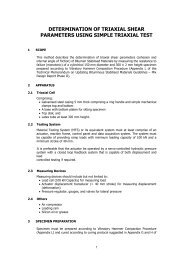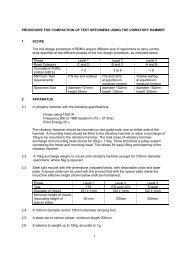Updating Bituminous Stabilized Materials Guidelines Mix Design Report Phase II
Moisture Sensitivity: Part II (Validation) - Asphalt Academy
Moisture Sensitivity: Part II (Validation) - Asphalt Academy
- No tags were found...
Create successful ePaper yourself
Turn your PDF publications into a flip-book with our unique Google optimized e-Paper software.
4. ANALYSIS AND DISCUSSION OF RESULTS<br />
The objective of this section is to provide an overview on the findings of MMLS3 testing and<br />
subsequent ITS testing on wet and dry trafficked BSMs. The results obtained in APT device<br />
(MMLS3) and ITS used to establish possible correlation or trend between MMLS3 and MIST<br />
device testing system. The relationships between these devices also provide an insight of<br />
moisture related damage on different BSMs. Through the results, screening of the different<br />
BSMs in terms of moisture susceptibility defined.<br />
In an attempt to observe the performance of proposed MMLS3 test set-up for the BSMs, the<br />
initial study tests conducted with different test variables. These variables include 680kPa tyre<br />
pressure, 1.2kN wheel load, and 7200wheel per hour, with installation of vinite layer at the top<br />
of briquettes. The additional tests however, were carried out at new testing variables to<br />
correlate with the variables predetermined for the MIST device. The new variables were 420kPa,<br />
1.8kN, and speed of 7200wheel per hour. The combination of new variables allowed acceptable<br />
number load application of MMLS3 trafficking and correlation with MIST device testing system<br />
on BSMs.<br />
The study of different factors related to moisture damage on the BSMs was investigated. These<br />
factors described in subsequent subsections.<br />
4.1 Load application on BSMs<br />
The impact of moisture on pavement performance differs depending on the type of pavement,<br />
loading condition, temperature, and degree of saturation. A BSM in pavement layer is used as<br />
base or subbase, in order to enable load distribution in the structure. The interaction of the<br />
surface traffic and pore pressure developed in BSMs due to ingress of water is complex. In this<br />
study, the MMLS3 test variables were scaled down to correlate with MIST device. Due to<br />
reduction of tyre pressure and wheel load, the installation of vinite or rubber mat layer used to<br />
ensure the pore pressure effect not reduced in the BSMs during trafficking. The installation of<br />
vinite or rubber mat does not simulate field conditions, but merely minimises direct abrasion of<br />
the wheels on the BSM-layer and help screening BSMs in terms of moisture related damage.<br />
As outlined above, different BMSs were investigated during MMLS3 and MIST testing in the<br />
laboratory. Figure J.17 present a comparison of BSMs performance on load application to failure<br />
in wet condition, at 25 o C, 420kPa, 1.8kN, and speed of 7200wheel per hour.<br />
22












